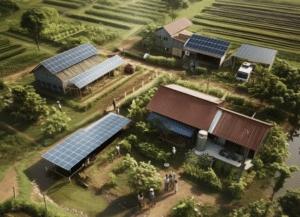Introduction – GAP Certification For Small Farms
GAP stands for “Good Agricultural Practices” and is a certification for farms, even small ones. Local farms, small farms, and community farms are ways to reduce reliance on distantly sourced food that contribute to carbon emissions.

Good Agricultural Practices (GAP) certification is an internationally recognized set of guidelines and standards that ensure food safety, reduce environmental impact, and promote worker safety and welfare.
For small farmers, obtaining GAP certification improves the quality and safety of their products and is great for sustainability and long-term viability of their farms. This article explores GAP certification for small farms – costs and benefits and its connection to sustainable living through carbon reduction and eco-friendly practices.
Although GAP does not mean organic, there is an overlap. With the new organic meat and poultry rules coming into play in 2024, GAP will overlap with efforts to bring farms into compliance.
Benefits of GAP Certification for Small Farms
Enhanced Food Safety and Better Management Practices
GAP certification results in small farms adopting better management practices, leading to improved food safety and quality. The rigorous standards set within GAP encourage farm owners to continuously develop and implement sanitation, hygiene, and pest control measures. This not only reduces foodborne illnesses but also enhances overall food quality.
Greater Market Access and Increased Consumer Confidence
Farmers with GAP certification often have better access to local and international markets, as the certification serves as a mark of quality and safety. Consumers are more likely to be confident in purchasing products that have undergone stringent food safety measures. By differentiating their produce, GAP-certified farms can potentially increase their market share and profitability.
Improved Traceability and Reduced Liability Risks
Adherence to GAP standards improves the traceability of food items through detailed record-keeping and labeling. In the event of a food safety issue, certified farms can track these products more effectively and reduce liability risks.
Modern technology like farm management software can significantly streamline this process. This software allows small farms to keep records digitally, making them more organized, easy to retrieve, and less prone to loss or damage compared to paper records. Barcode or QR code systems can be incorporated into packaging and labeling to track each product from farm to consumer.
Sustainable and Eco-Friendly Practices
Practices in line with the GAP certification contribute to sustainable living through reduced environmental impact and resource conservation. By implementing strategies such as organic farming techniques, integrated pest management, and water and energy conservation, GAP-certified farms minimize their carbon footprint and work towards a greener future.
The GAP Certification Process
Steps Involved in Certification
The certification process can vary depending on the specific GAP standard and certifying organization. In general, the process involves an initial self-assessment and thorough documentation of farm practices. Farmers then need to undergo training to ensure that all methods are up to the certification requirements.
Developing a Food Safety Plan
Incorporating sustainable practices into a food safety plan is crucial for meeting GAP certification standards. This plan will describe various measures employed on the farm, including pest and disease control, hygiene and sanitation, waste management, and use of chemicals and fertilizers.
On-Site Inspection and Verification
Once the food safety plan has been developed, the certifying body will conduct an on-site inspection to verify that the farm is following the plan and adhering to the established standards. Inspections may recur annually or every few years, depending on the chosen certification program.
Costs of GAP Certification – Process
Processes That Have Costs
The costs of obtaining GAP certification include initial assessment and inspection fees, training and implementation costs, as well as ongoing maintenance and annual re-certification fees. Costs may vary depending on the certifying body and specific farm size or location. It is not a single “catch-all” cost.
To ascertain these costs, small farmers can take several steps.
First, identify potential certifying bodies. In the United States, for instance, there are several USDA-accredited organizations that offer GAP certification services. Elsewhere, you might look to organizations recognized by the Global Food Safety Initiative (GFSI) or your country’s agricultural department.
Second, visit the official websites of these organizations. Most bodies provide detailed fee structures online, or at least provide a contact from whom such information can be obtained.
Third, reach out directly to these organizations for more specific cost inquiries. You can send an email, make a call, or even schedule a meeting. This step is particularly helpful as it gives you a chance to discuss your specific needs, farm size, and location which all contribute to the overall cost.
Remember that while the initial certification might appear costly, it should be viewed as an investment. GAP certification can open up new market opportunities, provide a marketing advantage, and potentially enable premium pricing for products. In addition, implementing the practices necessary for GAP certification can lead to efficiency improvements and cost savings in the long run. It’s also worth researching any government grants or subsidies that may be available to offset the costs of obtaining certification.
Estimating Costs
Keep in mind that these are rough estimates, and actual costs can vary significantly based on the size, location, and complexity of the farming operations:
- Initial assessment and inspection fees: The cost for the initial assessment and on-site inspections can vary greatly, but for a small farm, it could range between $500 and $1,500. This depends on the certifying body, farm size, and the complexity of your farm’s operations.
- Training costs: These costs depend on whether you seek external training or use available resources to train yourself and your staff. External training programs can range from $200 to $500 per person. Alternatively, there are many free or low-cost resources available online to guide farmers through the GAP certification process.
- Implementation costs: Implementing GAPs on your farm could range from a few hundred to a few thousand dollars, depending on the current status of your farm and the practices that need to be adopted. This includes costs for potential infrastructure changes, purchasing necessary equipment, and improving hygiene and safety procedures. We can’t estimate this part because of the huge variability for each situation.
- Ongoing maintenance costs: These involve costs for maintaining your GAP practices, such as regular equipment maintenance, record-keeping systems, and potential costs for sustaining your implemented changes. This could range from $100 to $500 annually.
- Annual re-certification fees: Annual re-inspection and re-certification fees can range between $200 and $800, depending on the certifying body and farm size.
Financial Assistance
Farmers seeking financial support for sustainable practices within their GAP certification process can look into government grants and subsidies or industry programs focused on eco-friendly farming. Some organizations, such as the USDA’s Natural Resources Conservation Service (NRCS), provide financial assistance to farmers implementing sustainable agriculture practices.
ShrinkThatFootprint has covered a large number of grants that increase production, organization and sustainable. The high tunnel grant is specifically for implementing a high tunnel solution that increase productivity. The REAP grant is for adding renewable energy to rural areas including farms. The Food Safety grant is particular relevant but is more along the lines of research, less so for implementation of systems. And finally, group-specific grants like female farm grants is another way to contribute to financial assistance of parts of achieving GAP.
Ways For Small Farms To Be Sustainable

While not a requirement, sustainable practices in line with the Good Agricultural Practices (GAP) certification reduce environmental impact and improve resource conservation. Small farmers can implement these eco-friendly practices in a number of manageable ways.
Small farmers can opt for organic farming techniques such as crop rotation, intercropping, and using compost or green manure for soil fertility, instead of synthetic fertilizers and pesticides. These methods improve soil health and biodiversity, decrease dependence on chemical inputs, and can result in a more resilient farm system overall.
For pest management, small farmers can adopt an integrated pest management approach. This strategy uses a combination of biological, cultural, physical, and chemical methods to manage pests. For example, a farmer might introduce beneficial insects that prey on harmful pests, use crop varieties that are naturally resistant to specific pests, or use traps and barriers to protect crops.
Water conservation can be achieved by employing techniques such as drip irrigation or rainwater harvesting, which not only save water but also reduce the cost of irrigation. Energy conservation measures might include utilizing solar panels for powering farm operations or using energy-efficient machinery and equipment.
Through these strategies, GAP-certified small farms can minimize their carbon footprint and work towards a greener future, even with limited resources. Adopting sustainable practices not only benefits the environment but can also improve farm productivity, reduce input costs, and enhance marketability of farm products among eco-conscious consumers.
Connecting with GAP Certified Farms
Locating Sustainable Farms
You can use online resources, such as the USDA’s National Farmers Market Directory or Local Harvest, to find GAP certified farms in your area that emphasize sustainable practices.
Farmer’s Markets and Local Food Networks
Many GAP-certified farms focused on sustainability participate in farmer’s markets and utilize local food networks, promoting their eco-friendly practices alongside food safety standards.
Conclusion
GAP certification is an essential aspect of sustainable living for small farms. By pursuing certification and implementing sustainable practices, farm owners can enhance food safety, promote eco-friendly agriculture, and contribute to a greener future
